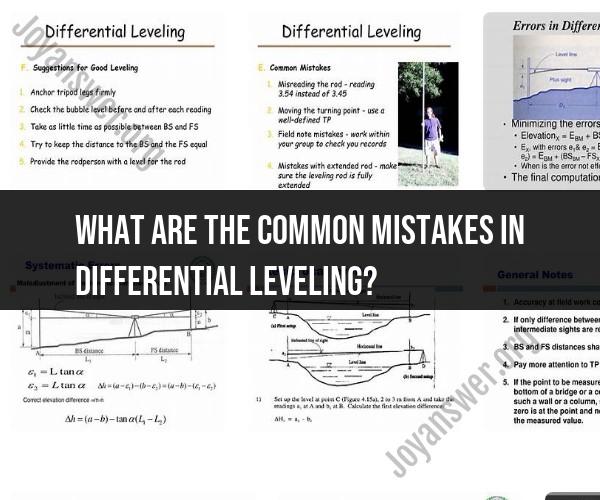What are the common mistakes in differential leveling?
Differential leveling is a precise surveying technique used to measure the difference in elevation between two points. While it is highly accurate when performed correctly, there are several common mistakes that can lead to errors in the results. Here are some of the most common mistakes in differential leveling:
Instrument Calibration Errors:
- Failure to properly calibrate the leveling instrument can introduce systematic errors into the measurements. It's essential to check and adjust the instrument's settings before starting any leveling work.
Misreading the Staff or Rod:
- Misinterpreting the measurement on the leveling staff or rod can lead to incorrect readings. Surveyors need to accurately read the graduations on the staff or rod, especially when using a graduated staff without a digital readout.
Failure to Level the Instrument:
- The leveling instrument must be leveled precisely using built-in bubble levels before taking measurements. If the instrument is not leveled correctly, it can introduce significant errors into the readings.
Incorrect Backsighting:
- Backsighting involves measuring the elevation of a known point (a benchmark) before moving to the points of interest. Errors in backsighting can propagate through subsequent measurements, leading to cumulative errors.
Improper Focusing:
- Failing to focus the instrument's crosshairs correctly on the leveling staff or rod can result in parallax errors. Parallax occurs when the crosshairs appear to move relative to the staff due to incorrect focusing.
Temperature and Refraction Effects:
- Changes in temperature and atmospheric conditions can affect the density of air and, consequently, the path of the light through the instrument. This can cause refraction errors that impact measurement accuracy.
Instrument Stability:
- Vibrations or movement of the leveling instrument during measurements can lead to inaccurate readings. Surveyors should ensure a stable setup to minimize these errors.
Line of Sight Obstructions:
- Objects obstructing the line of sight between the instrument and the staff can result in measurement errors. Surveyors need to choose measurement locations with a clear line of sight.
Failure to Record Data Properly:
- Incorrectly recording readings or failing to document important details, such as the instrument height, can lead to data errors and difficulties in later analysis.
Inadequate Survey Control:
- Failing to establish a network of control points or benchmarks can limit the accuracy and reliability of the leveling results. A lack of control points makes it challenging to tie the leveling data to a known reference.
Overlooked Systematic Errors:
- Systematic errors, such as curvature and refraction effects over long distances, can accumulate and lead to inaccuracies in the final results. Surveyors should be aware of and account for these errors when necessary.
To minimize these common mistakes in differential leveling, it is crucial to follow established surveying procedures, use well-maintained equipment, and exercise care and precision during the entire surveying process. Additionally, regularly checking and calibrating instruments, documenting survey details, and ensuring proper instrument leveling are essential practices for accurate leveling results.


